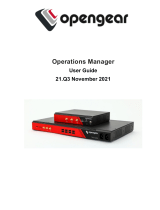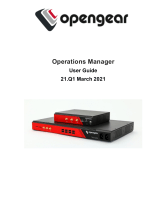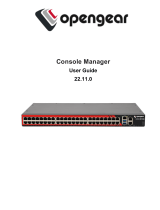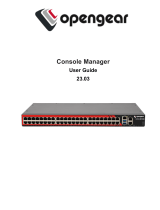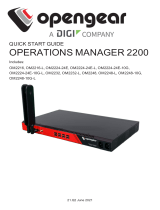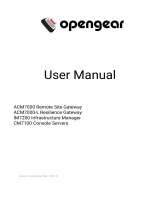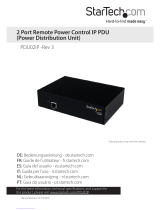Page is loading ...

Operations Manager
User Guide
23.03

Contents
Contents 2
Copyright © 10
Document Revision History 11
Safety & FCC Statement 12
Safety Statement 12
FCC Warning Statement 12
About This User Guide 14
Installation And Connection 15
Power Connection 16
Dual Power Supply 18
SNMP Alerts for Power-related Events 19
SNMP Alert Configuration 19
Device Status LEDs 20
Connecting to the Network 22
Serial Connection 23
Cellular Connectivity 24
Installing A New SIM Card 24
Cellular Modem Antenna Gain Specifications 25
Reset and Erase 26
Initial Settings 27
Default Settings 28
Using the Web GUI 29
Management Console Connection via CLI 31

Accessing the Web GUI CLI Terminal 31
Change the Root Password 32
Disable a Root User 34
Change Network Settings 35
MONITOR Menu 39
System Log 40
LLDP CDP Neighbors 41
Triggered Playbooks 42
ACCESS Menu 43
Local Terminal 44
Access Serial Ports 45
Quick Search 46
Access Using Web Terminal or SSH 46
Serial Port Logging 47
CONFIGURE Menu 49
Configure Serial Ports 50
Edit Serial Ports 51
Autodiscovery 53
Local Management Consoles 57
Lighthouse Enrollment 59
Manual Enrollment Using UI 60
Manual Enrollment Using the CLI 61
Playbooks 62
Create Or Edit a Playbook 62
PDUs 67
Add and Configure a PDU 67
PDU Operation 69

System Alerts 70
System Alerts - General 71
Authentication 71
Configuration 71
System Alerts - Power 72
Enable Power Supply Syslog Alerts 72
System Alerts - Temperature 74
Configure SNMP System Temperature Alerts 74
System Alerts - Networking (Connection Status) 76
Configure Signal Strength Alerts 76
Network Connections 78
Network Interfaces 79
DNSConfiguration 80
Configure DNS via the Web UI 80
Configure DNS via the Command Line 81
Dual SIM 83
Display SIM Status and Signal Strength 83
Installing A New SIM Card 85
Select The Active SIM (Manual Failover Mode) 86
Select The Primary SIM (Automatic Failover Mode) 87
Dual SIM Automatic Failover 89
Failover Modes 91
Activate or Configure Automatic Failover 92
Cellular Interface Policy Settings 93
Network Aggregates - Bonds and Bridges 95
Bridges 95
Bonds 98
Spanning Tree Protocol 102
Enable STP in a Bridge 103
Bridge With STPEnabled - UI 103
Bridge With STPEnabled - OGCLI 103

Bridge With STPDisabled - OGCLI 104
IPsec Tunnels 105
Create, Add or Edit IPsec Tunnels 105
Static Routes 110
Configure Static Routes 111
Managing Static Routes via CommandLine 112
Network Resilience 115
Out Of Band Failover 116
Optional Additional Probe Address 117
Enable Out-of-Band Failover 118
DNS Queries on a Dormant Failover Interface 120
OOB Failover Types & Failover Behavior 121
IP Passthrough 123
User Management 125
Groups 126
Permission Changes in the Web UI 126
Understanding Access Rights 126
Understanding Serial Port Access 131
Create a New Group 134
Edit an Existing Group 136
Local Users 137
Create a New User With Password 138
Create a New User With No Password (Remote Authentication) 139
Modify An Existing User Account With Password 139
Manage SSH Authorized Keys for a User Account 140
Delete a User's Account 141
Remote Authentication 142
Configure RADIUS Authentication 143
Configure TACACS+ Authentication 144
Configure LDAP Authentication 146
Local Password Policy 148

Set Password Complexity Requirements 149
Set Password Expiration Interval 150
Password Policy Implementation Rules 151
Services 153
Brute Force Protection 154
Configure Brute Force Protection 154
Viewing Current Bans 155
Managing Brute Force Protection via Command Line 156
HTTPS Certificate 158
Network Discovery Protocols 160
Routing 162
Dynamic Routing 162
Static Routing (via the ogcli) 163
SSH 165
Unauthenticated SSH to Serial Ports 166
Enable Unauthenticated SSH 166
Enable SSH 167
Enable/Disable 167
Connecting Directly to Serial Ports 168
Feature Persist 169
Properties and Settings 169
Syslog 172
Add a New Syslog Server 172
Global Serial Port Settings 173
Edit or Delete an Existing Syslog Server 174
Session Settings 175
File Server 177
Enable TFTPService 177
Update The TFTP Service Storage Location 178
SNMP Service 180
SNMP Alert Managers 181

Multiple SNMP Alert Managers 182
Create or Delete an SNMPManager 182
New SNMP Alert Manager Page Definitions 183
Firewall 185
Firewall Management 186
Firewall Zone Settings 187
Port Forwarding 187
Manage Custom Rules 188
Firewall - Source Address Filtering 189
Interzone Policies 191
Create an Interzone Policy 191
Edit or Delete an Interzone Policy 193
Customized Zone Rules 193
System 194
Administration 195
Date & Time 196
Manual Date & Time Set 197
NTP Configuration & Authentication 197
CLI Commands Associated with NTP Configuration 199
Factory Reset 201
Reboot 202
Export Configuration 203
Export Configuration via WebUI 203
Export Configuration via ogcli 204
Control The Export Of Sensitive Data 204
Lighthouse Node Backup 205
Restore Configuration 206
Restore Configuration Via Web UI 206
Import Configuration via ogcli 208
System Upgrade 209
Upgrade Via Fetch From Server 210

Upgrade Via Upload 210
Advanced Options 211
Communicating With The Cellular Modem 212
Opengear CLI Guide 214
Getting Started with ogcli 214
Basic Syntax 215
Common Configuration Examples 221
Config Shell Guide 228
Start and End a Config Shell Session 228
Navigate in the Config Shell 229
Fields, Entities and Contexts 229
Global Context Commands 231
Entity Context Commands 231
Apply or Discard Field Changes 232
Operations 233
Supported Entities 233
Example CLI Commands 235
Configuring a Port 238
Advanced Portmanager PMShell Guide 239
Running pmshell 239
pmshell Commands 240
Custom Control Codes for Serial Ports 241
Configure Custom Control Codes 241
Configure Control Codes for a Specified Port (CLI Examples) 242
Configure a Control Code Value for All Ports 243
Docker 244

Copyright ©
Opengear Inc. 2023. All Rights Reserved.
Information in this document is subject to change without notice and does not
represent a commitment on the part of Opengear. Opengear provides this document
“as is,” without warranty of any kind, expressed or implied, including, but not limited
to, the implied warranties of fitness or merchantability for a particular purpose.
Opengear may make improvements and/or changes in this manual or in the product
(s) and/or the program(s) described in this manual at any time. This product could
include technical inaccuracies or typographical errors. Changes are periodically
made to the information herein; these changes may be incorporated in new editions
of the publication.
23.03 Copyright © 10

Document Revision History
Document
Version Number Revision Date Description
22.11.0 November 2022 Updates to:
Group Permissions - enhancements
NTP Configuration added
Serial Port logging data counters
Serial Port autodiscovery
System Alerts - UI layout changes
23.03 March 2023 Updates to OOB Failover - additional
probe address added.
Added Firewall - Source Address
Filtering
23.03 Document Revision History 11

Safety & FCC Statement
Safety Statement
Please take care to follow the safety precautions below when installing and
operating the Operations Manager:
lDo not remove the metal covers. There are no operator serviceable
components inside. Opening or removing the cover may expose you to
dangerous voltage which may cause fire or electric shock. Refer all service to
Opengear qualified personnel.
lTo avoid electric shock the power cord protective grounding conductor must be
connected through to ground.
lAlways pull on the plug, not the cable, when disconnecting the power cord from
the socket.
Do not connect or disconnect the appliance during an electrical storm. Also use a
surge suppressor or UPS to protect the equipment from transients.
FCC Warning Statement
This device complies with Part 15 of the FCC rules. Operation of this device is
subject to the following conditions: (1) This device may not cause harmful
interference, and (2) this device must accept any interference that may cause
undesired operation.
Proper back-up systems and necessary safety devices should be utilized
to protect against injury, death or property damage due to system failure.
Such protection is the responsibility of the user.
23.03 Safety & FCC Statement 12

This device is not approved for use as a life-support or medical system.
Any changes or modifications made to this device without the explicit
approval or consent of Opengear will void Opengear of any liability or
responsibility of injury or loss caused by any malfunction.
This equipment is for indoor use and all the communication wiring are
limited to inside of the building.
23.03 Safety & FCC Statement 13

About This User Guide
This user guide is up to date for the 23.03 firmware release. When using a minor
release there may or may not be a specific version of the user guide for that release.
This User Guide is applicable to the range of Operations Manager models. Where
the term Operations Manager (or OM) is used, this will generally include all
Operations Manager variants unless a particular variant is specified.
23.03 About This User Guide 14

Installation And Connection
This section describes how to install the appliance hardware and connect it to
controlled devices.
23.03 Installation And Connection 15

Power Connection
OM2200 devices may be powered by either AC or 12V DC power supply. The
OM1200 is available with 12V DC power only.
AC Powered OM2200s have dual power inlets with auto failover built in. These
power supplies each accept AC input voltage between 100 and 240 VAC with a
frequency of 50 or 60 Hz. The OM2224-24E-10G-L draws a maximum of 48W, while
non-24E are less than 30W.
Two IEC AC power sockets are located on the power side of the metal case, and
these IEC power inlets use conventional IEC AC power cords.
Note: Country specific IEC power cords are included with the AC OM2200.
See also "Dual Power Supply" on page18 and "System Alerts - Power" on page72.
Operations Manager Platform (OM2200) Environmental And Power
Power Supply Dual AC or 12V DC
Power Draw 48 Watts for -24E, others <30W
Operating conditions Temperature 5~50C, Rel Humidity 5~90%
Cooling Passive
Environmental Sensors Smart Controller with multi-zone temperature
sensors
Supervisory environmental controller with safety
power down.
Power Draw Sensors Active multi-zone power draw monitoring
DC Powered OM1200
23.03 Installation And Connection 16

All OM1200 devices are shipped with a 12VDC to universal AC (multi-country clips)
wall adapter and a barrel-jack connector. Additional AC to DC adapters may be
ordered.
Operations Manager Platform (OM1200) Environmental And Power
Power Supply 12V DC
Power Draw < 25 Watts
Operating conditions Temperature 5~50C, Rel Humidity 5~90%
Cooling Passive
Environmental Sensors Smart Controller with multi-zone temperature
sensors.
Auto-shutdown/re-boot on severe thermal events
Power Draw Sensors Active multi-zone power draw monitoring
23.03 Installation And Connection 17

Dual Power Supply
Dual Power Supply can provide power redundancy for devices, especially those that
may operate in harsher environments. A secondary power supply provides
redundancy for the device if one PSU is unplugged or in the event of a failure.
LED Power Status Indicator
The power LED indicator requires no configuration and will display the dual power
status on any Operations Manager device with a dual power supply.
On a device with a single PSU (power supply unit) or, a dual PSU device has
power connected to two PSUs, the LED power status indicator should be green at
all times.
If a dual PSU device has power connected to one PSU (power supply unit), the LED
power status indicator is colored amber indicating that the unit has no redundancy in
the event of a power failure.
23.03 Installation And Connection 18

SNMP Alerts for Power-related Events
The System Voltage Range SNMP alert is triggered when there is a change in power
status such as a system reboot or when the voltage on either power supply leaves or
enters the configured range of the System Voltage alert.
SNMP Alert Configuration
The System Voltage Range SNMP alert is configured in the Configure > SNMP
Alerts page, see "System Alerts - Power" on page72.
23.03 Installation And Connection 19

Device Status LEDs
The LED states shown below are determined through infod status and config-server
data. The config server holds a configurable threshold value for the Cell LED Amber
/ Green light, and modem enabled / disabled information.
Status LEDs
LED Condition
LED Off Amber
Flashing Amber Solid Green
Flashing Green Solid
Power Device is off. On a dual
power supply
system:
Only one PSU
is connected.
On a single
power supply
system:
power is con-
nected.
On a dual
power supply
system:
Redundant
power is con-
nected.
Heartbeat Device has hal-
ted.
Device is
booting.
Normal
operation.
Device is
halted.
Network No active net-
work con-
nection
Device is fail-
over starting.
Device is in fail-
over.
Normal network
connection is
stopping or nor-
mal network is
up and failover
is stopping.
Network is
connected.
23.03 Installation And Connection 20
/

